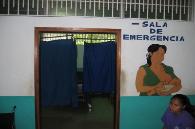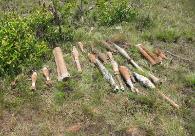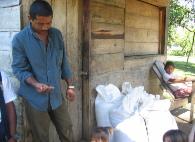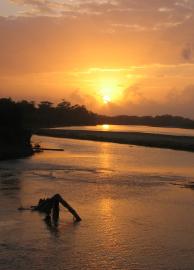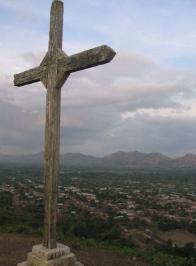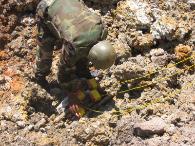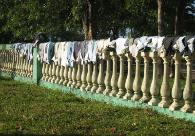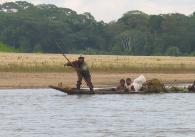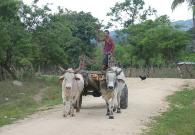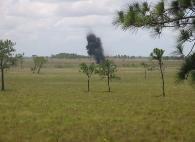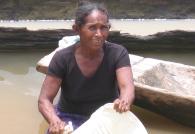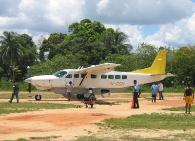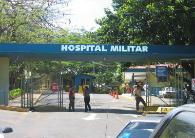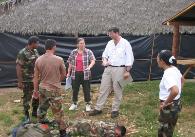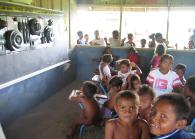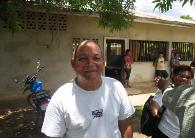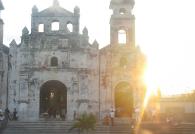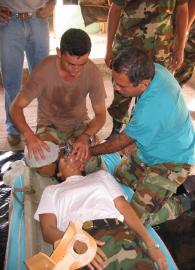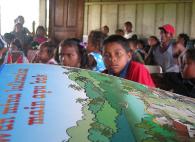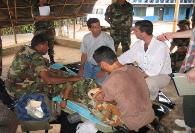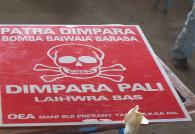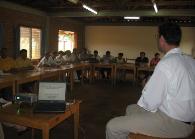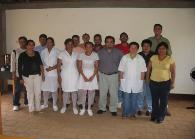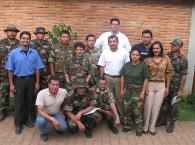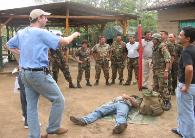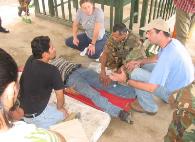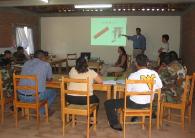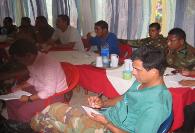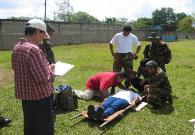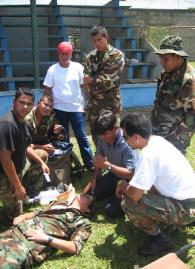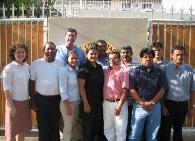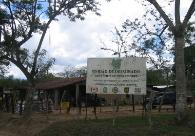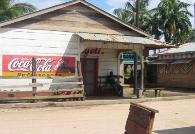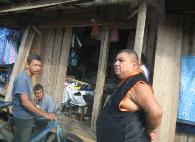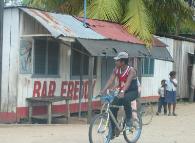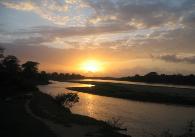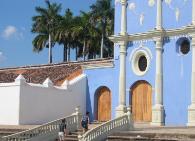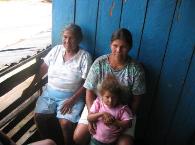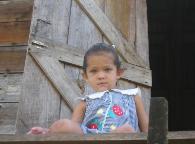Nicaragua:
Nicaragua Update 2004.1
Hola from Nicaragua!
I must say that satellite technology is amazing as this update is being sent from the
only internet café in the town of Waspan in northeastern Nicaragua. For those of
you who are not familiar with Waspan (which included me until a few days ago) it is a
sleepy little town of about 5,000 people on the Rio Coco, Nicaragua’s largest river
and its northern border with Honduras.
This region of Nicaragua is home to the Mesquito people, a local indigenous
population with their own language; although luckily for me many speak Spanish. Not
that my Spanish is so good, but let me say, its amazing how much one’s speaking
ability improves when there is no alternative.
So as many of you know I am in Nicaragua because of the landmine situation in this
part of the country. During the conflict in the 1980s with the Sandinistas and Contras
many landmines were placed along the northern border with Honduras. The job of
removing the mines is being overseen by the Organization of American States (OAS)
with the actual demining being accomplished by the Nicaraguan military.
Last November while I was at a conference in Bogotá, Colombia on Landmine Victim
Assistance we had some discussions about the lack of first aid and trauma training
for the demining units and for the local populations. In addition, it seemed that if we
could get funding, we could possibly set up a program to have U.S. surgeons visit
landmine affected regions in Nicaragua and provide trauma support and also work
with local surgeons to provide essential surgical care for the population.
The proposal for such a project was approved by the U.S. State Department and I am
currently here doing some training and also a feasibility study to see if and where
would be good places for surgeons to be based.
I arrived on Wednesday April 14, 2004 had a nice lunch meeting with the OAS
demining directors and toured their offices. I then met up with Simon, a Swiss guy
who works for the Geneva International Center for Humanitarian Demining. Later,
Simon, his wife and I went out for a very typical Nicaraguan dinner: sushi - complete
with California and Philadelphia rolls.
Managua is very large and spread out. There is no real center to speak of and it
really just sprawls. There are very few very tall buildings, and although there is some
new construction, much of the city is run down, having been damaged by
earthquakes, war or just general neglect. It’s currently the end of the dry season and
things are on the brown and dried out side, but not too dusty. The traffic is not too
bad, and people actually obeyed the traffic signals, something which I haven’t been
too familiar with recently in developing countries.
When flying into Managua we passed over a large lake which I am told is extremely
polluted, and which in the past had fresh water sharks. At least that’s what the
vascular surgery fellow who I sat next to on the plane told me. It was pretty funny that
the guy in the seat next to me was reading some medical type articles and when I
asked what flavor of doc he was, he went into this long explanation of vascular
surgery and what he did. I told him I was quite familiar with the specialty.
On the ride into town from the airport, which is quite new and nice, I also noticed that
there is a great deal of construction occurring with road and infrastructure projects.
It seems as if money is starting to flow into the country and everyone I met kept telling
me how Nicaragua is the safest country in Central America. Hmm, didn’t know that.
Anyway, I stayed in an area called the Zona Rosa, which is where there are a number
of nice hotels and restaurants and just across the street was a Burger King in case I
got homesick.
The next morning I flew in a smallish prop plane to Waspan. The guide book I have
spoke about the pilots having to call the airstrip before they land in order to shoo the
cattle off the runway, and sure enough, it’s a dirt airstrip with cows, pigs, donkeys,
and dogs running around. I also should not forget all the little kids that showed up to
watch the plane land. It’s quite a daily event for the town.
I was met at the airstrip by the local OAS personnel. We went to the office, stopped
by El Piloto (the pilot) Hotel, a fairly new and nice (relatively) place run by a former
pilot who spent a few years in the States and speaks English. It’s really nice that
there’s air conditioning, although the fact that there is no electricity in the town from 1
a.m. to 8 a.m. and from 12 p.m. to 2 p.m. is just something one must accept.
After dropping off my bags we stopped by the local health center and spoke with one
of the doctors about the workshop which I will hold next week. The plan is to have
two two-day workshops for the demining docs and one two-day session for the local
docs. It was almost comical when I was given a list of possible topics to cover as it
included: thoracic trauma, abdominal trauma, GI bleeding, fluids and electrolytes,
acute abdomen, vascular lesions, acute cholecystitis, acute appendicitis, ectopic
pregnancy, craneo-facial trauma, antibiotic usage, hypovolemic shock, polytrauma,
and knots and sutures. I told that doc that I would do what I could, but that they
should maybe pare down the list a bit. I had really planned to do mainly a trauma
review. I have a bunch of material including PowerPoint presentations for abdominal
and thoracic trauma and other general surgery topics. I’d also like to do some
scenarios and practice in their trauma area. They are supposed to get back to me
early next week.
It was then off to the military base where we met with the officer in charge of the
Nicaraguan Army unit doing the demining. We had a nice lunch of chicken, rice and
beans (something which was going to become quite common). We discussed the
broad plans and thoughts on the workshops and I agreed to return later in the
afternoon to discuss specifics with the doctors and paramedics working with the
deminers.
The meeting with the medical folks started out fairly restrained, in part because my
Spanish is sub-optimal and I think the docs where a little unsure about who was this
Gringo and there was a bit of, “What the hell was he doing coming in and trying to
tell us what to do?” I tried to explain that the plan was to do a trauma and first aid
workshop, but that I though it would be best if they told me first what they felt would
be best. We decided that the first day would be didactic and the second day would
be scenarios at the demining sites.
We also made plans to meet the following day so that I could show them all the
material I had brought and so that they might understand a bit more about where I
was coming from. There was one general surgeon, one orthopod and one
anesthesiologist in this group.
Early the next day we drove about forty five minutes to the village of Bilwaskarma.
There is a health center there with an operating theater, a decent lab and an
ultrasound machine. There is one physician who basically does everything himself
and when I asked about trauma and surgery he said that there is some limited
capability, but most cases were referred to Puerto Cabeza about two hours to the
east where there is a bigger hospital. The OR in Bilwaskarma is used when they
have minor cases or when there are emergencies that can not wait. The doc said
that in the past it has been used by international teams who have shown up with a
surgeon, anesthesiologist and nurses and they have run clinics for limited time. I’m
not sure this is the best way to do things. A team could come down and use the
facilities, but I’d rather find a fully functioning surgical service where U.S. docs could
come down and help out, rather than set up their own parallel system. This is also
the facility that would be used for any emergent operations that would be needed for
demining personnel injured on the job.
After heading back to Waspan I saw my first medical case, a referral from the mayor.
She was a 79 year woman who has had 6 years of epigastric to left sided abdominal
pain which is worse after meals. The note from the Mayor’s office stated that she
had appendicitis and needed an operation, an ultrasound report showed gallstones
and a recommendation to see a surgeon. Basically, without any right sided
tenderness, a pulse rate of 72, no fever and long standing pain, I’m going to go for
ulcer disease, treat her for H. pylori and see what happens. We don’t have H2
blockers or Prilosec here, but we do have some antibiotics and something like pepto-
bismol. We’ll see what happens in a few days.
The afternoon meeting with the demining medical folks went very well. I started by
showing them a presentation on Damage Control surgery that I’m going to give to the
docs at the Military Hospital in Managua on May 7th. The general surgeon was very
interested and then we went over some other presentations that I had on abdominal
trauma, thoracic trauma, an ICRC video on the management of landmine injuries,
some videos from the U.S. Army on first aid for landmine victims, presentations I’ve
put together for paramedics as first responders and a presentation on first aid for
mine awareness personnel. Much of the information was taken from sources such as
the ICRC, the International Physicians for the Prevention of Nuclear War (IPPNW)
Primary Management of Landmine Injuries booklet, ATLS, PHTLS, the Wilford Hall
TRCS course, and the US Army medic training and soldier first aid materials.
We decided that the workshops would be geared toward the paramedics with the
plan that I would work with the docs so that they would be able to do some training in
the future. It would be a bit of “train the trainer.” I told them that I would prefer if they
could do all the teaching in the future and they agreed. We also made plans hands
on scenarios which I am very eager to do. It does not appear that they are regularly
having any accident training drills, although luckily there has not been a dimining
injury since 2000.
The docs and I talked more on Saturday and decided that the workshops would be
primarily for the paramedics, a review of basic first aid and ABC’s type things and
stabilization. I also showed them the list of topics for the local health personnel and
they offered to help me with the training. I would like to make it more informal and
more as a discussion session where we go over cases and scenarios rather than just
lecture to them. It was also interesting that as the military doctors got more excited
about the information I was giving them, their English also got much better. We even
got to the point where we were exchanging bad jokes. Oh, and in case anyone was
wondering, a Nicaraguan translator is arriving Monday morning to help with the
workshops so the students and I don’t have to suffer.
On Saturday morning we got up early and went by small boat up the Rio Coco to the
next village (it wasn’t quite Apocalypse Now, but it did make me wonder) to make
arrangements for a mine awareness training session that will be held in the school on
Monday. We were told that there are 524 children who attend the school. It’s a
smallish building with three indoor rooms and two areas with seats and a blackboard
outside. There are morning and afternoon sessions.
When we got to the village we were greeted by many of the children who looked at us
shyly. One of the locals showed us the problem he was having in that it had rained
the day he had harvested his beans and so his supply was germinating and basically
useless. Although he had rice, plantains and other food supplies it was going to be a
heavy burden on the family.
It was interesting to see the houses which are all built out of planks of wood and
appear to be single room dwellings. They are all built up on stilts which is to keep
them dry during the rainy season when there is much flooding and mud. During the
rainy season the roads become almost impassable, while trips down the river to
Puerto Cabeza take about half an hour instead of two hours when the river is very
shallow.
Things in town are a little better. The main street is concrete and there are about a
dozen small shops selling everything from T-shirts with logos for the Yankees and the
Bulls to plastic flip-flops and mops. Of course you can get Coca-cola or the local
beer either Victoria or Tona. It’s really amazing to walk around town and see cows
just roaming or pig going through refuse on the side of the street. At night the sky is
fantastically clear and all the stars are very visible.
On a final note, things seem very safe here. There is a small military presence with
the base located in Waspan, but one does not see soldiers in town. While we were in
the village up the river we did see a patrol pass by but they looked more bored than
anything else.
Basically things are off to a good start. Things are totally different from what I
expected, but like always I think all will work out well. I am a bit disappointed in that I
will probably not be operating, but hopefully I’ll be able to set something up for the
future. If not, I just may have to see about getting back to Malawi.
Hope all is well with everyone.
Adios,
Nicaragua Update 2004.2
Well, Waspan (or Waspam – I’ve seen it written both ways) is actually not a bastion of
civilization that some of you may have been led to believe. On Saturday the
electricity didn’t come on at 8 a.m. and by 10 a.m. we were starting to wonder. Turns
out, the local generating station had a problem that couldn’t be fixed and they had to
send for a technician from Managua. Of course there is no airplane service
Saturday afternoon or on Sunday for that matter, so…no electricity for the entire
town, no air conditioning at the hotel (and it’s been getting hotter and hotter), the
battery for my computer died and of course no internet.
However, it was actually quite pleasant being in a place that sort of functioned as
usual without power. Everyone used candles at night and I ended up turning in
pretty early. There was no hanging out at the local disco and no point in drinking
warm beer. Most people here were pretty content and are used to such outages.
Anyway, I’m now back in the OAS office in Managua and all is well. Tomorrow I’ll be
running a landmine first aid course for the mine awareness personnel. As for how
thing went in Waspan; I’m pretty happy.
The first course was on Monday and Tuesday. It didn’t start until the afternoon
because the translators (two women who were not medical types) didn’t arrive until
after 11 a.m. and then we had lunch and then with the power off from 12 until 2 p.m. I
couldn’t use the projector for my power point presentation. But things finally got
started and went on for about 5 hours. I went over the whole ABC’s of trauma care
(Airway, Breathing, and Circulation: for the non-medical types) and then covered
some specifics of management. The talk was heavily based on the care of landmine
victims, specifically deminers but I made sure to include plenty of other trauma
mechanisms as well.
There were 14 people in the group which included 7 paramedics and 7 doctors, one
of whom was an orthopod. They are all civilians, except for the one chief doctor, who
is a Captain and runs the medical unit.
Our plan was to meet the next day at 8 a.m. but in typical military “hurry up and wait”
fashion things didn’t get started until about nine. We all had to get to the baseball
field, get the keys to the place, kick the goats off the field and avoid the herd of
cows. But eventually the military medical types showed up with their equipment,
stretchers, medical packs, ambu-bags and such and we were ready to begin.
I had written a number of scenarios based upon various types of injuries. Two were
specifically for deminers at the site, but others were civilian injuries including
landmines and also blunt and penetrating trauma. We went through the cases and I
had the paramedics role play victims and had the groups break up into teams as it
would be in the field. We went down different pathways and if poor decisions were
made, “the patient’s” outcome suffered.
All in all they did very well and had a good time. We were able to cover some things
that they had learned in the lectures and I was also able to go over and clarify quite a
number of issues and procedures. We then went back and watched a few videos to
reinforce what they had learned. Afterwards we had lunch and a discussion of what
was good and where things could be improved. They seem genuinely please with
the workshop, although they wanted more in-depth coverage of some topics and a bit
more instruction on some procedures. Having a syllabus distributed ahead of time
and in Spanish would also have been helpful. I was able to add more for the next
workshop, but the translation will have to wait until I get back to Managua.
On Monday I also got a revised list of topics from the docs at the community center.
It was still ridiculously long, almost an entire review of surgery, and I decided to make
things mainly a trauma review. I also was able to get the military orthopod to agree to
give a talk on fractures to the local docs on Saturday. I got a tour of the local health
center. It was newly refurbished and painted and really quite spacious, clean and
nice. There’s plenty of examination rooms, a delivery room, a small minor OR for
tubal ligations and other small procedures, but basically, all surgical cases are
referred to Peurto Cabeza. There is however, no dedicated trauma area.
Oh, and as for a bit more information, I have if from a reliable source that the name
Miskito is not derived from the insect, but from the Spanish word “mosquete” meaning
musket which were provided by the British. Also interestingly, the Miskito language
only uses the vowels “a,” “i,” and “u.” It’s supposedly very easy for Gringo to learn
because many words are similar including rais n bins for rice and beans, denki for
thanks, siknes for sick and klin for clean, but don’t ask me how they got nakisma for
how are you? and aisabi for goodbye.
Anyway, the second workshop started on Wednesday at 8 a.m. and included 13
participant, 7 paramedics and 6 doctors including 1 general surgeon and an
anesthesiologist. Based upon the changes recommended by the first group this
session included a bit more technical information with separate lectures on
abdominal and thoracic trauma and shock. I also made copies of the slides as
handouts and used more of the videos and photos I had to emphasis my points. The
session went all day and we finished around 5 p.m. The group seemed to enjoy the
session and we had a few spirited discussions on some management issues
especially between the general surgeon and the anesthesiologist.
We met the next day at the hotel at 8 a.m. and this time went to the military base for
the scenarios. We decided that standing out in the hot sun as we had done with the
previous group was sub-optimal and the base worked out much better. We even got
the Captain in charge of all the demining operations to participate in some of the
scenarios. Again it was a very useful exercise.
The post workshop evaluation comments after this course included the desire for
material in Spanish, mannequins and the ability to have more such training programs
and possibly animal labs. One of the female doctors who had actually just returned
from 6 months in Iraq mentioned that she had previously had some training with US
Special Forces types and had been able to do some procedures on goats. That
raised the issue of why the OAS was willing to have me do these training sessions,
and the main reason is because with the current situation in Afghanistan and Iraq it
seems unlikely that SF guys will be heading down to Nicaragua in the near future to
do any training exercises.
Needless to say I’m pretty happy with the way everything turned out and now have a
set presentation and scenarios for the groups we are going to train next week in the
town of Jalapa.
Oh, and also on the issue of Iraq. I was a bit surprised to hear that Nicaragua had
contributed to the multinational force that was based south of Baghdad, though I sort
of remember hearing about it. What really shocked me though was the fact that the
US$ 700,000 needed for the troops to go was supposedly donated by…an
anonymous source. My guess is that it isn’t the same “anonymous” who often
donates to museums and other cultural institutions.
On Friday the local doctors from the community clinic came to the hotel for a day
long seminar. I decided to concentrate mainly on basic trauma management,
including the abdominal and thoracic and shock lectures. I decreased the amount of
landmine related information, but still included a section on the different patterns of
injures and initial management.
For those of you who don’t know, there are three different patterns of landmine
injuries. Type 1 injuries are when someone steps on a landmine and it causes a
traumatic amputation of the foot, it also usually injures the opposite leg, genitals and
possibly the hands. A type 2 injury is from a fragmentation or bounding mine, which
can explode at a waist high level. These injuries can be to any part of the body, and
if the victim survives they may have abdominal, chest or extremity injuries. Type 3
injuries occur when someone is handling a landmine. The blast usually results in the
amputation of one or both hands and severe facial injuries and often blindness.
Needless to say these are pretty horrific injuries and the pictures I use in the
presentations really demonstrate that point.
During the afternoon session on Friday one of the doctors mentioned that a patient
had presented to the clinic during the lunch break and asked if I would see him
afterwards, of course I agreed. His story was that he was working in a field and a
neighbor cut down a tree and it fell on him. He had tried to run away, but it landed on
his left shoulder and back. When I saw the guy in the clinic he was smiling and
looking good. On questioning him it turned out that the injury had happened the
previous morning. He said he had been unconscious for a period and when he woke
up his son was about to administer mouth to mouth. He had a clavicle fracture and
the docs had him in a bit of a splint for that. He complained mainly of weakness and
a shooting numbness down his left arm and the inability to raise the arm. I first went
to check his cervical spine and when I gently palpated in the mid-line he cried out in
pain. He had real mid-line tenderness. Now this may be residual from the impact,
but I told the docs that they needed to get this guy immediately into a collar and get x-
rays. The problem, of course is that while there is an x-ray machine, there are no
films or supplies and the x-ray machine in the nearby hospital is not functioning
either. Therefore the plan was to have him travel down to Puerto Cabeza in order to
get the necessary studies. Ah, third world medicine, sometimes it can be really
frustrating.
We met the following day at 8 a.m. and luckily I hadn’t prepared any slide
presentations because that was the day that there was no power. My plan, which
worked out well was to have each of the docs present a case and then we would
discuss what was done and what could have been done differently. I was also able to
interject various other trauma and surgical type things. We did that for the morning
and waited for the lights to come back on. Unfortunately since they never did, the
military orthopedic surgeon was not able to give his presentation. I was pleased,
however, that the orthopod, the general surgeon and another medical doc showed
up for the local doc’s to meet. Hopefully there will be more cooperation between the
two groups in terms of lectures and teaching and also in terms of patient care.
I’ve decided that my favorite part of the day in Waspam is in the evening just after the
sun sets. The sun sets over the river with bright plumes of brilliant oranges and
purples billowing up in the sky. It’s a different sky from Africa, but still beautiful. But
just after the sun sets, the main street is busy with people shopping, merchants
showing their wares, and older women and young children bring out and cooking
food at the side of the road. People also use this time to burn the day’s garbage.
The streets are crowed with young people out from school and it’s almost like the
village rush hour. The setting darkness gives a bluish-grey tinge to everything and
the smoke, almost like a fog, from the burning fires reminds me of other poverty
stricken villages I’ve visited in China and India and Thailand. It’s the smell of poverty,
but not of hopelessness. It’s the smell of people working and making a living and
existing in their small and often isolated communities. It’s not an offensive or harsh
smell. I guess it’s the smell of the third world.
Another amazing thing about Waspan is the number of animals just wondering the
streets. I can’t remember being in a place where the pigs and piglets running around
and eating the garbage out-numbered the local dogs, but this is the place. There
are also quite a few cows who just roam the streets, especially at night. They eat the
grass at the side of the road or nibble on some of the produce that dropped to the
ground from one of the stalls in the small local shops and the market. I’m not saying
that things are as “bad” as in India, but let’s just say, this place runs a close second.
Not to leave out other species, there are also goats, chickens, roosters, horses and
donkeys which freely roam the streets.
As for the weather, it was wonderful. Sunny days with low humidity in the mid and
upper 80’s, cool at night, and I sometimes had to shut off the air conditioning well
before the power stopped at 2 a.m. There were a few rain showers, but nothing
really to speak of, and they stop almost immediately. Toward the end of the week,
however, it got progressively warmer.
I am frequently amazed at how friendly everyone is given the fact that I’m an
American (or more accurately, a North American). In fact the other evening while I
was walking down the main street, one of the local drunks passed by and said, “Hola,
doctor.” I guess people in town know who the tall Gringo is.
When talking to folks about things in the 80’s it seems that it was really bad, both
from the safety point of view and also economically. But no one feels any animosity
toward me as an American. In fact many people have either worked in the States for
a period of time, or have relatives there who send back money. Barry, the pilot, who
runs the hotel, learned to fly in the US (that probably wouldn’t happen today) on the
days that the cruise ship that he worked on was in port in Miami. He flew for many
years in Honduras and was forced to retire at age 60 and then spent four years in
Miami working at various jobs to make money to build the hotel. His wife supervised
the construction, while he was sending down the greenbacks.
Anyway, they are a really lovely couple. And the food turned out to be surprisingly
good. I’ve moved on from chicken and rice and beans. One night we had some wild
game whose name I couldn’t pronounce and that they couldn’t really describe,
something with a short snout and large rump, we joked that it was jungle rat. I think it
does belong to the rat family. It was, however, pretty good and…did NOT taste like
chicken; it had more of a pork taste. We also had a local favorite called ‘rundon’
which is a kind of stew, not to be confused with a soup (though I could have called it
a soup) made with fresh coconut milk, fresh fish, yucca, plantains and banana. It was
wonderful. We had beef with French fries and one evening even enjoyed coconut
water and rum. The one problem is that there is actually too much food and it’s all
very high in carbs, in fact it’s mostly carbs. Good old Dr. Atkins would have found it
very difficult going to Waspan.
As for night life, last weekend I did manage to get to the town’s hot spot. According
to Barry (the Pilot) the place to go on a Saturday night was “Discotek Koo Fu” a
place run by the Chineseman. And yes, it’s a disco. Complete with black lights, loud
music and dancing. It’s also the only real place to go in town. So much so that I met
up with many of the locals that we had met; none of whom of course had mentioned
the place. It was certainly interesting to see, but nothing compared to the discos in
Malawi.
So after finishing with the three courses, Sunday was a welcome rest. I ended up
going with the OAS team of mine awareness guys who were going down the river to
do a training session in one of the local villages. The village turned out to be a two
and a half hour boat ride down stream. It was often slow going because it is now the
end of the dry season and the river is very shallow. At each bend there were long
sandbanks on one side of the river and sharp cliffs of eroded jungle on the opposite
side. The time sped by as we rode down toward the village. People paddling dugout
canoes, herons and hawks and children playing in the water were the main views.
Often we had to push ourselves over shallow portions of the river to get past. There
were numerous trees that had fallen into the river and created obstacles or little
islands around them. At one point we were not just zigzagging around the fallen
trees, but actually slaloming.
When at last we reached the village we were met by a horde of children. It seems
that the children are always eager to come to the mine awareness talks and the guys
had previously given a talk to them during a school day. This talk was aimed more at
the adults. The children were all crowding around us but they kept staring at the tall
gringo. Why am I not surprised.
We stayed about two hours and then got back in the boat for the trip up the river.
We arrived back in Waspan just as the sun was setting.
The plan for the rest of my stay in Nicaragua is to give the first aid course to the mine
awareness personnel tomorrow and then head to the town of Jalapa on
Wednesday. In Jalapa the plan is to do the training for two groups of military docs
and one for the community.
As far was finding out about surgical facilities, I heard from the military surgeon that
there are two surgeons who practice in a district called Las Minas. Supposedly they
do every type of surgery in their small hospital. This is the type of opportunity that I
think would be best suited for having US surgeons come down and help. Hopefully I’ll
can get more information about them from the folks in Managua.
Adios for now,
Nicaragua Update 2004.3
Well, I made it back to Managua after spending 10 days in the town of Jalapa in the
departmento (province) of Nuevo Segovia. Somehow I miraculously survived without
internet access.
To recap, we left Managua on the 27th and made the three hour drive to Ocotal fairly
easily. That segment of road is part of the Pan-American Highway and is well paved
and marked. We stopped along the way at a few road side stands, once to get
watermelon and once for coffee and a rolled tortilla with cheese. The guys were also
eager for me to see one of the local restaurants where they serve “exotic” foods such
as boa, crocodile, iguana and a few other things I didn’t actually recognize. It was
part zoo, part restaurant. We just stopped to look around as it was early morning.
The countryside just outside Managua was dry and not very scenic, a bit like west
Texas; a dry plane slowly transforming into rolling hills with brown scrub and few
trees. We headed north through the department of Matagalapa and passed through
the city of Esteli. This is a big cigar making center where many Cubans emigrated
after Castro came to power. Many of the tobacco products are sold strictly for export.
Continuing further north into the mountains the landscape gradually transformed,
becoming progressively greener and more scenic. The ridges are not, however,
covered with the numbers of trees that one might expect and this is the result of
severe deforestation by the local population and the effects of a fungus. This issue
is a major environmental problem facing people in northern Nicaragua and southern
Honduras.
We stopped for about an hour in Ocotal, it’s where the OAS regional headquarters is
and had lunch: chicken and rice and beans. One staple of the diet here is the
ubiquitous rice and beans. But it’s not just a plain side of rice and a side of beans, it’
s a combination called gallo pinto (which translates into “painted rooster.”) It is
basically a fried rice and red bean mixture. Rice and beans, or painted rooster. Call
it what you will it’s served at almost every meal.
The road out of Ocotal was quite an experience. It’s not paved, or at least it’s not
mostly paved, even though there are sections where they are grading the road and
putting in paving stones. The sections that are finished are great; however, most of
it is a rutted, bumpy, dusty dirt road that goes up and down the mountain sides,
across streams and through small villages for two and a half hours. Occasionally
water trucks pass and spray the road to keep the dust down. Large semi’s pulling
flat bed trailers carry much of the goods to Jalapa and produce back to Ocotal; many
locals climb aboard to hitch rides. Mini-traffic jams occur when the trucks attempt to
pass each other or maneuver through the numerous detours around the sections
where there is construction.
The country side is quite beautiful with forested areas and low ridges of mountains.
The highest peak in Nicaragua is a little over 6000 feet (2000 meters) and is in this
area.
We finally arrived in Jalapa just before sunset and went straight to the hotel. It’s
called the Pantano which translates into, “The Swamp.” Now this place is by far the
best hotel in town and the reason for the name is because it is also the name for a
type of tree in the area. I was informed of this by the owner who is a middle-aged
Dutch guy named Guillermo, though I’m guessing that’s not the name his folks gave
him when he was born in Rotterdam. The story is he first came to Jalapa 9 years ago
as a forestry engineer, married a local girl and when the funding for his project ran
out, he sold his house in Holland and built the hotel.
Needless to say, it’s a fairly nice place. There is a large conference room which
functioned very well for the presentations, a large restaurant and eating area
(complete with dance floor) and plenty of local Latin American music favorites
constantly being blared on the CD player by one of the waitress/DJ’s. The rooms are
comfortable with private baths, showers and even TV. The one thing that is missing
is internet. No budding entrepreneur has set up a satellite internet café yet, but I can’
t believe it won’t be happening soon.
Anyway, Jalapa is a town which was heavily affected by Contra attacks during the war
in the 1980’s. In fact this part of the county has been a hot bed of unrest for some
time and was also the area where the US Marines were quite active during the 1920’s
and 1930’s. Knowing that does help to explain the lighter features and blue eyes of
some of the locals.
The town is situated in a fertile valley and is surrounded by ridges covered by trees
and green vegetation. The climate here is much more comfortable that in Managua
with warm days, low humidity and cool nights. Tobacco, corn and produce consumed
by other Nicaraguans is grown locally.
The town is certainly wealthier than Waspan, however, we’re not talking rich here.
Remember the whole country is exceedingly poor. The population is supposedly
around 32,000 and though it is significantly larger than Waspan it lacks much of the
(limited) charm. Jalapa is a grid of about 20 by 30 square blocks. Only two streets
are paved with stones, the rest are just dirt and gravel. The buildings are single
story and constructed out of concrete or cinderblocks and are painted in faded white
or pastel colors. The place looks dreary and there is no real center. It’s got a bit of
the look and feel of a stagnant border town along the Texas-Mexico border, the main
difference of course is that it’s along the Nicaragua-Honduras border and there is no
Wal-Mart anywhere. There is a small two block market area selling the usual plastic
goods, bags, t-shirts and vegetables, but it’s nothing to speak of. There is a bank
which even has a Western Union sign prominently displayed and a bunch of small
“mom and pop” stores and one smallish supermarket.
One thing which always delights me is seeing the guys riding their carts being pulled
by horses, donkeys or oxen. More times than not they are wearing cowboy hats.
Around noon and in the early evening the streets are filled with children walking
home from school. They are all dressed in the same uniform, white tops and navy
pants for the boys, navy skirts for the girls.
As for the medical scene, the Nuevo Segovia region appears to be much better for
setting up a rotation for surgeons. I visited the district hospital in Ocotal which has
two local surgeons. They are a referral center for most of the departmento, although
they refer many of the more serious cases to Managua. The hospital has 97 beds
and no intensive care, however, I was told they do about 1 to2 emergent cases a day
and about 8 or so elective cases a week. They have x-ray facilities, but no
ultrasound. I met one of the general surgeons and he was very interested in the
prospect of having some assistance. I think this place would be perfect to work for a
month or two. One problem is that no one in the hospital speaks English. (Of course
I mean that this is a problem for any Gringo who would want to go down and work
there.)
I also got a tour of the hospital in Jalapa and was surprised and impressed. It is a 23
bed facility also without an ICU. They have a newly refurbished operating room which
was very nice. They are currently in the process of finishing the construction so no
operations were currently taking place. There is however, a surgeon, orthopod and
an anesthesiology tech. I was told that a group from Minnesota comes down a few
times a year to spend about a month or so doing surgery. I am hoping to find out a
bit more information.
As for the courses, the first one in Jalapa was with the community medical folks. 23
people attended and this included nurses, doctors and a few surgical specialists.
Things went all day Thursday and for the morning on Friday; it all went very
smoothly. The participants included folks from Jalapa, Ocotal and half a dozen from
the town of San Fernando about an hour outside of Ocotal on the road to Jalapa.
We had the weekend off, in part due to the Labor Day holiday on Saturday. May 1st
was Labor Day in Nicaragua as it was in much of the world. CNN in Español treated it’
s viewers to a live broadcast of Fidel Castro’s speech, I watched for as long as I
could stand it. Things were pretty quite but I did manage to get to a few of the local
night spots with some of the doctors from the course and on Sunday hiked up to the
top of one of the peaks for a splendid view down into the valley.
The class for the military folks began on Monday with 15 docs and paramedics. I
finally got the whole presentation to the point that I’m pretty happy with it and it went
very smoothly. Tuesday was spent at the military base doing the scenarios. They all
enjoyed it and then we went back to the hotel where we had lunch. Just to add a
touch of the absurd, the chief doctor brought his keyboard/synthesizer and
proceeded to serenade the group while we ate. He wasn’t bad, but it was still pretty
strange.
On the subject of strange, one afternoon during a break we had ice cream. I usually
don’t eat ice cream in the developing world, but this time the cone looked pretty
good. Well, it was OK, nothing really special, but I couldn’t quite place the taste. I
mean it wasn’t unpleasant, just not a flavor I was used to, I probably wouldn’t have
had it again on my own. Well, needless to say, one of the translators started
reminiscing about how her mother used to make ice cream for her birthday and that
their favorite flavor was prune. Yup, it was then that I realized the flavor of the ice
cream I was eating. Prune ice cream. That has to go right up there with Hong Kong’
s tuna fish donuts.
One thing I really love is the unpredictability of the place. For example, on Monday
night at about 8:30 while sitting outside of the restaurant and writing, the power for
the entire town just cut out. The music stopped abruptly and the only light was from
the screen of my laptop. Nobody reacted. A few candles were lit and then they tried
to start the hotel generator. It took a few tries but they eventually got it going. The
town lights eventually kicked back on a half hour later. That wasn’t too bad
considering the electricity was off for about 6 hours on Sunday for supposed routine
maintenance.
There is also the daily question of which animal on the hotel grounds is going to act
as my alarm clock. Occasionally it’s the rooster, of course, but more often than not it’
s one of the cows mooing or the goats making goat sounds or one of the 6 German
Shepard mix dogs telling everyone to “up and ‘atem.”
The second group of military docs consisted of 12 physicians and paramedics. They
were a much quieter group than the previous one, but really seemed to be soaking in
the information. A few appeared to be writing down every word I said. Well, not quite
every word I said, but every word I said which was than translated into Spanish so
every word the translators said.
Needless to say we calculated the final numbers for the training courses and they
included:
54 demining medical personnel (2 day course)
40 community medical personnel (2 day course)
10 mine awareness personnel (1 day course)
94 total
This morning I also gave two talks at the Military Hospital in Managua. After a brief
introduction by the Vice Minister of Defense I gave an overview lecture on the
“Emergency Management of Landmine Injuries.” It included a good deal of ICRC
material include a video segment. Next I gave a more technical talk on Damage
Control Surgery (bases partially on a presentation developed by Don Jenkins at
Wilford Hall) to 40 surgeons and anesthesia folks. They both went very well and I
was told they had press releases and the whole thing should be in tomorrow’s
newspaper.
One interesting thing is that everything is going so well, I keep hearing the question
of when will I return. Now, that’s not actually for me to decide, however, I must say, if
and when I return I’d like to get to do some clinical surgery in addition to the teaching
stuff.
Anyway, on Saturday I will be heading back for New York. I must say that I think this
project was quite a success. I am hopeful that we will be able to start getting other
surgeons and maybe orthopods and ER folks down there to help out and teach
trauma type things. I want to also acknowledge the help of the OAS, especially
Carolos Orsco the Nicaragua Director, Juan Jose in the Waspam office and Rámon in
the Ocotal office for all their assistance and support in making everything happen
and run smoothly. In addition, the US State Department’s Office of Weapons
Abatement Humanitarian Demining Program (I didn’t decide on the name so don’t
blame me) deserves special thanks for providing funding for the project. Hopefully
we will have additional funding made available in the future.
In terms of some other things I noticed about life here in Nicaragua, firstly, almost all
the buses traveling on the roads are school buses, complete with the “Stop” sign by
the driver’s window. Some are painted in gaudy colors, but many are just school bus
orange. I can’t imagine taking 5 hour trips over dirt roads in one of them, but I guess
when you have no other choice it’s the way to go.
Another thing is that there are no actual street addresses in the entire country.
Locations are described by where they are in relationship to a certain landmark or
where a former landmark was and then a direction and distance is given. For
example the address for the Piloto Hotel in Waspan was: From the mayor’s office
300 meters on the left toward the river (North). Saying that something is up from the
place where the large tree was, means that it’s to the east from where the large tree
used to be. Two blocks down from the park is two blocks to the west. Up is east
because that is where the sun comes up, and west is down because that is the
direction the sun sets. And it’s like this for the whole country.
That’s all for now,
Adios,
Nicaragua Update 2004.1
Hola from Nicaragua!
I must say that satellite technology is amazing as this update is being sent from the
only internet café in the town of Waspan in northeastern Nicaragua. For those of
you who are not familiar with Waspan (which included me until a few days ago) it is a
sleepy little town of about 5,000 people on the Rio Coco, Nicaragua’s largest river
and its northern border with Honduras.
This region of Nicaragua is home to the Mesquito people, a local indigenous
population with their own language; although luckily for me many speak Spanish. Not
that my Spanish is so good, but let me say, its amazing how much one’s speaking
ability improves when there is no alternative.
So as many of you know I am in Nicaragua because of the landmine situation in this
part of the country. During the conflict in the 1980s with the Sandinistas and Contras
many landmines were placed along the northern border with Honduras. The job of
removing the mines is being overseen by the Organization of American States (OAS)
with the actual demining being accomplished by the Nicaraguan military.
Last November while I was at a conference in Bogotá, Colombia on Landmine Victim
Assistance we had some discussions about the lack of first aid and trauma training
for the demining units and for the local populations. In addition, it seemed that if we
could get funding, we could possibly set up a program to have U.S. surgeons visit
landmine affected regions in Nicaragua and provide trauma support and also work
with local surgeons to provide essential surgical care for the population.
The proposal for such a project was approved by the U.S. State Department and I am
currently here doing some training and also a feasibility study to see if and where
would be good places for surgeons to be based.
I arrived on Wednesday April 14, 2004 had a nice lunch meeting with the OAS
demining directors and toured their offices. I then met up with Simon, a Swiss guy
who works for the Geneva International Center for Humanitarian Demining. Later,
Simon, his wife and I went out for a very typical Nicaraguan dinner: sushi - complete
with California and Philadelphia rolls.
Managua is very large and spread out. There is no real center to speak of and it
really just sprawls. There are very few very tall buildings, and although there is some
new construction, much of the city is run down, having been damaged by
earthquakes, war or just general neglect. It’s currently the end of the dry season and
things are on the brown and dried out side, but not too dusty. The traffic is not too
bad, and people actually obeyed the traffic signals, something which I haven’t been
too familiar with recently in developing countries.
When flying into Managua we passed over a large lake which I am told is extremely
polluted, and which in the past had fresh water sharks. At least that’s what the
vascular surgery fellow who I sat next to on the plane told me. It was pretty funny that
the guy in the seat next to me was reading some medical type articles and when I
asked what flavor of doc he was, he went into this long explanation of vascular
surgery and what he did. I told him I was quite familiar with the specialty.
On the ride into town from the airport, which is quite new and nice, I also noticed that
there is a great deal of construction occurring with road and infrastructure projects.
It seems as if money is starting to flow into the country and everyone I met kept telling
me how Nicaragua is the safest country in Central America. Hmm, didn’t know that.
Anyway, I stayed in an area called the Zona Rosa, which is where there are a number
of nice hotels and restaurants and just across the street was a Burger King in case I
got homesick.
The next morning I flew in a smallish prop plane to Waspan. The guide book I have
spoke about the pilots having to call the airstrip before they land in order to shoo the
cattle off the runway, and sure enough, it’s a dirt airstrip with cows, pigs, donkeys,
and dogs running around. I also should not forget all the little kids that showed up to
watch the plane land. It’s quite a daily event for the town.
I was met at the airstrip by the local OAS personnel. We went to the office, stopped
by El Piloto (the pilot) Hotel, a fairly new and nice (relatively) place run by a former
pilot who spent a few years in the States and speaks English. It’s really nice that
there’s air conditioning, although the fact that there is no electricity in the town from 1
a.m. to 8 a.m. and from 12 p.m. to 2 p.m. is just something one must accept.
After dropping off my bags we stopped by the local health center and spoke with one
of the doctors about the workshop which I will hold next week. The plan is to have
two two-day workshops for the demining docs and one two-day session for the local
docs. It was almost comical when I was given a list of possible topics to cover as it
included: thoracic trauma, abdominal trauma, GI bleeding, fluids and electrolytes,
acute abdomen, vascular lesions, acute cholecystitis, acute appendicitis, ectopic
pregnancy, craneo-facial trauma, antibiotic usage, hypovolemic shock, polytrauma,
and knots and sutures. I told that doc that I would do what I could, but that they
should maybe pare down the list a bit. I had really planned to do mainly a trauma
review. I have a bunch of material including PowerPoint presentations for abdominal
and thoracic trauma and other general surgery topics. I’d also like to do some
scenarios and practice in their trauma area. They are supposed to get back to me
early next week.
It was then off to the military base where we met with the officer in charge of the
Nicaraguan Army unit doing the demining. We had a nice lunch of chicken, rice and
beans (something which was going to become quite common). We discussed the
broad plans and thoughts on the workshops and I agreed to return later in the
afternoon to discuss specifics with the doctors and paramedics working with the
deminers.
The meeting with the medical folks started out fairly restrained, in part because my
Spanish is sub-optimal and I think the docs where a little unsure about who was this
Gringo and there was a bit of, “What the hell was he doing coming in and trying to
tell us what to do?” I tried to explain that the plan was to do a trauma and first aid
workshop, but that I though it would be best if they told me first what they felt would
be best. We decided that the first day would be didactic and the second day would
be scenarios at the demining sites.
We also made plans to meet the following day so that I could show them all the
material I had brought and so that they might understand a bit more about where I
was coming from. There was one general surgeon, one orthopod and one
anesthesiologist in this group.
Early the next day we drove about forty five minutes to the village of Bilwaskarma.
There is a health center there with an operating theater, a decent lab and an
ultrasound machine. There is one physician who basically does everything himself
and when I asked about trauma and surgery he said that there is some limited
capability, but most cases were referred to Puerto Cabeza about two hours to the
east where there is a bigger hospital. The OR in Bilwaskarma is used when they
have minor cases or when there are emergencies that can not wait. The doc said
that in the past it has been used by international teams who have shown up with a
surgeon, anesthesiologist and nurses and they have run clinics for limited time. I’m
not sure this is the best way to do things. A team could come down and use the
facilities, but I’d rather find a fully functioning surgical service where U.S. docs could
come down and help out, rather than set up their own parallel system. This is also
the facility that would be used for any emergent operations that would be needed for
demining personnel injured on the job.
After heading back to Waspan I saw my first medical case, a referral from the mayor.
She was a 79 year woman who has had 6 years of epigastric to left sided abdominal
pain which is worse after meals. The note from the Mayor’s office stated that she
had appendicitis and needed an operation, an ultrasound report showed gallstones
and a recommendation to see a surgeon. Basically, without any right sided
tenderness, a pulse rate of 72, no fever and long standing pain, I’m going to go for
ulcer disease, treat her for H. pylori and see what happens. We don’t have H2
blockers or Prilosec here, but we do have some antibiotics and something like pepto-
bismol. We’ll see what happens in a few days.
The afternoon meeting with the demining medical folks went very well. I started by
showing them a presentation on Damage Control surgery that I’m going to give to the
docs at the Military Hospital in Managua on May 7th. The general surgeon was very
interested and then we went over some other presentations that I had on abdominal
trauma, thoracic trauma, an ICRC video on the management of landmine injuries,
some videos from the U.S. Army on first aid for landmine victims, presentations I’ve
put together for paramedics as first responders and a presentation on first aid for
mine awareness personnel. Much of the information was taken from sources such as
the ICRC, the International Physicians for the Prevention of Nuclear War (IPPNW)
Primary Management of Landmine Injuries booklet, ATLS, PHTLS, the Wilford Hall
TRCS course, and the US Army medic training and soldier first aid materials.
We decided that the workshops would be geared toward the paramedics with the
plan that I would work with the docs so that they would be able to do some training in
the future. It would be a bit of “train the trainer.” I told them that I would prefer if they
could do all the teaching in the future and they agreed. We also made plans hands
on scenarios which I am very eager to do. It does not appear that they are regularly
having any accident training drills, although luckily there has not been a dimining
injury since 2000.
The docs and I talked more on Saturday and decided that the workshops would be
primarily for the paramedics, a review of basic first aid and ABC’s type things and
stabilization. I also showed them the list of topics for the local health personnel and
they offered to help me with the training. I would like to make it more informal and
more as a discussion session where we go over cases and scenarios rather than just
lecture to them. It was also interesting that as the military doctors got more excited
about the information I was giving them, their English also got much better. We even
got to the point where we were exchanging bad jokes. Oh, and in case anyone was
wondering, a Nicaraguan translator is arriving Monday morning to help with the
workshops so the students and I don’t have to suffer.
On Saturday morning we got up early and went by small boat up the Rio Coco to the
next village (it wasn’t quite Apocalypse Now, but it did make me wonder) to make
arrangements for a mine awareness training session that will be held in the school on
Monday. We were told that there are 524 children who attend the school. It’s a
smallish building with three indoor rooms and two areas with seats and a blackboard
outside. There are morning and afternoon sessions.
When we got to the village we were greeted by many of the children who looked at us
shyly. One of the locals showed us the problem he was having in that it had rained
the day he had harvested his beans and so his supply was germinating and basically
useless. Although he had rice, plantains and other food supplies it was going to be a
heavy burden on the family.
It was interesting to see the houses which are all built out of planks of wood and
appear to be single room dwellings. They are all built up on stilts which is to keep
them dry during the rainy season when there is much flooding and mud. During the
rainy season the roads become almost impassable, while trips down the river to
Puerto Cabeza take about half an hour instead of two hours when the river is very
shallow.
Things in town are a little better. The main street is concrete and there are about a
dozen small shops selling everything from T-shirts with logos for the Yankees and the
Bulls to plastic flip-flops and mops. Of course you can get Coca-cola or the local
beer either Victoria or Tona. It’s really amazing to walk around town and see cows
just roaming or pig going through refuse on the side of the street. At night the sky is
fantastically clear and all the stars are very visible.
On a final note, things seem very safe here. There is a small military presence with
the base located in Waspan, but one does not see soldiers in town. While we were in
the village up the river we did see a patrol pass by but they looked more bored than
anything else.
Basically things are off to a good start. Things are totally different from what I
expected, but like always I think all will work out well. I am a bit disappointed in that I
will probably not be operating, but hopefully I’ll be able to set something up for the
future. If not, I just may have to see about getting back to Malawi.
Hope all is well with everyone.
Adios,
Nicaragua Update 2004.2
Well, Waspan (or Waspam – I’ve seen it written both ways) is actually not a bastion of
civilization that some of you may have been led to believe. On Saturday the
electricity didn’t come on at 8 a.m. and by 10 a.m. we were starting to wonder. Turns
out, the local generating station had a problem that couldn’t be fixed and they had to
send for a technician from Managua. Of course there is no airplane service
Saturday afternoon or on Sunday for that matter, so…no electricity for the entire
town, no air conditioning at the hotel (and it’s been getting hotter and hotter), the
battery for my computer died and of course no internet.
However, it was actually quite pleasant being in a place that sort of functioned as
usual without power. Everyone used candles at night and I ended up turning in
pretty early. There was no hanging out at the local disco and no point in drinking
warm beer. Most people here were pretty content and are used to such outages.
Anyway, I’m now back in the OAS office in Managua and all is well. Tomorrow I’ll be
running a landmine first aid course for the mine awareness personnel. As for how
thing went in Waspan; I’m pretty happy.
The first course was on Monday and Tuesday. It didn’t start until the afternoon
because the translators (two women who were not medical types) didn’t arrive until
after 11 a.m. and then we had lunch and then with the power off from 12 until 2 p.m. I
couldn’t use the projector for my power point presentation. But things finally got
started and went on for about 5 hours. I went over the whole ABC’s of trauma care
(Airway, Breathing, and Circulation: for the non-medical types) and then covered
some specifics of management. The talk was heavily based on the care of landmine
victims, specifically deminers but I made sure to include plenty of other trauma
mechanisms as well.
There were 14 people in the group which included 7 paramedics and 7 doctors, one
of whom was an orthopod. They are all civilians, except for the one chief doctor, who
is a Captain and runs the medical unit.
Our plan was to meet the next day at 8 a.m. but in typical military “hurry up and wait”
fashion things didn’t get started until about nine. We all had to get to the baseball
field, get the keys to the place, kick the goats off the field and avoid the herd of
cows. But eventually the military medical types showed up with their equipment,
stretchers, medical packs, ambu-bags and such and we were ready to begin.
I had written a number of scenarios based upon various types of injuries. Two were
specifically for deminers at the site, but others were civilian injuries including
landmines and also blunt and penetrating trauma. We went through the cases and I
had the paramedics role play victims and had the groups break up into teams as it
would be in the field. We went down different pathways and if poor decisions were
made, “the patient’s” outcome suffered.
All in all they did very well and had a good time. We were able to cover some things
that they had learned in the lectures and I was also able to go over and clarify quite a
number of issues and procedures. We then went back and watched a few videos to
reinforce what they had learned. Afterwards we had lunch and a discussion of what
was good and where things could be improved. They seem genuinely please with
the workshop, although they wanted more in-depth coverage of some topics and a bit
more instruction on some procedures. Having a syllabus distributed ahead of time
and in Spanish would also have been helpful. I was able to add more for the next
workshop, but the translation will have to wait until I get back to Managua.
On Monday I also got a revised list of topics from the docs at the community center.
It was still ridiculously long, almost an entire review of surgery, and I decided to make
things mainly a trauma review. I also was able to get the military orthopod to agree to
give a talk on fractures to the local docs on Saturday. I got a tour of the local health
center. It was newly refurbished and painted and really quite spacious, clean and
nice. There’s plenty of examination rooms, a delivery room, a small minor OR for
tubal ligations and other small procedures, but basically, all surgical cases are
referred to Peurto Cabeza. There is however, no dedicated trauma area.
Oh, and as for a bit more information, I have if from a reliable source that the name
Miskito is not derived from the insect, but from the Spanish word “mosquete” meaning
musket which were provided by the British. Also interestingly, the Miskito language
only uses the vowels “a,” “i,” and “u.” It’s supposedly very easy for Gringo to learn
because many words are similar including rais n bins for rice and beans, denki for
thanks, siknes for sick and klin for clean, but don’t ask me how they got nakisma for
how are you? and aisabi for goodbye.
Anyway, the second workshop started on Wednesday at 8 a.m. and included 13
participant, 7 paramedics and 6 doctors including 1 general surgeon and an
anesthesiologist. Based upon the changes recommended by the first group this
session included a bit more technical information with separate lectures on
abdominal and thoracic trauma and shock. I also made copies of the slides as
handouts and used more of the videos and photos I had to emphasis my points. The
session went all day and we finished around 5 p.m. The group seemed to enjoy the
session and we had a few spirited discussions on some management issues
especially between the general surgeon and the anesthesiologist.
We met the next day at the hotel at 8 a.m. and this time went to the military base for
the scenarios. We decided that standing out in the hot sun as we had done with the
previous group was sub-optimal and the base worked out much better. We even got
the Captain in charge of all the demining operations to participate in some of the
scenarios. Again it was a very useful exercise.
The post workshop evaluation comments after this course included the desire for
material in Spanish, mannequins and the ability to have more such training programs
and possibly animal labs. One of the female doctors who had actually just returned
from 6 months in Iraq mentioned that she had previously had some training with US
Special Forces types and had been able to do some procedures on goats. That
raised the issue of why the OAS was willing to have me do these training sessions,
and the main reason is because with the current situation in Afghanistan and Iraq it
seems unlikely that SF guys will be heading down to Nicaragua in the near future to
do any training exercises.
Needless to say I’m pretty happy with the way everything turned out and now have a
set presentation and scenarios for the groups we are going to train next week in the
town of Jalapa.
Oh, and also on the issue of Iraq. I was a bit surprised to hear that Nicaragua had
contributed to the multinational force that was based south of Baghdad, though I sort
of remember hearing about it. What really shocked me though was the fact that the
US$ 700,000 needed for the troops to go was supposedly donated by…an
anonymous source. My guess is that it isn’t the same “anonymous” who often
donates to museums and other cultural institutions.
On Friday the local doctors from the community clinic came to the hotel for a day
long seminar. I decided to concentrate mainly on basic trauma management,
including the abdominal and thoracic and shock lectures. I decreased the amount of
landmine related information, but still included a section on the different patterns of
injures and initial management.
For those of you who don’t know, there are three different patterns of landmine
injuries. Type 1 injuries are when someone steps on a landmine and it causes a
traumatic amputation of the foot, it also usually injures the opposite leg, genitals and
possibly the hands. A type 2 injury is from a fragmentation or bounding mine, which
can explode at a waist high level. These injuries can be to any part of the body, and
if the victim survives they may have abdominal, chest or extremity injuries. Type 3
injuries occur when someone is handling a landmine. The blast usually results in the
amputation of one or both hands and severe facial injuries and often blindness.
Needless to say these are pretty horrific injuries and the pictures I use in the
presentations really demonstrate that point.
During the afternoon session on Friday one of the doctors mentioned that a patient
had presented to the clinic during the lunch break and asked if I would see him
afterwards, of course I agreed. His story was that he was working in a field and a
neighbor cut down a tree and it fell on him. He had tried to run away, but it landed on
his left shoulder and back. When I saw the guy in the clinic he was smiling and
looking good. On questioning him it turned out that the injury had happened the
previous morning. He said he had been unconscious for a period and when he woke
up his son was about to administer mouth to mouth. He had a clavicle fracture and
the docs had him in a bit of a splint for that. He complained mainly of weakness and
a shooting numbness down his left arm and the inability to raise the arm. I first went
to check his cervical spine and when I gently palpated in the mid-line he cried out in
pain. He had real mid-line tenderness. Now this may be residual from the impact,
but I told the docs that they needed to get this guy immediately into a collar and get x-
rays. The problem, of course is that while there is an x-ray machine, there are no
films or supplies and the x-ray machine in the nearby hospital is not functioning
either. Therefore the plan was to have him travel down to Puerto Cabeza in order to
get the necessary studies. Ah, third world medicine, sometimes it can be really
frustrating.
We met the following day at 8 a.m. and luckily I hadn’t prepared any slide
presentations because that was the day that there was no power. My plan, which
worked out well was to have each of the docs present a case and then we would
discuss what was done and what could have been done differently. I was also able to
interject various other trauma and surgical type things. We did that for the morning
and waited for the lights to come back on. Unfortunately since they never did, the
military orthopedic surgeon was not able to give his presentation. I was pleased,
however, that the orthopod, the general surgeon and another medical doc showed
up for the local doc’s to meet. Hopefully there will be more cooperation between the
two groups in terms of lectures and teaching and also in terms of patient care.
I’ve decided that my favorite part of the day in Waspam is in the evening just after the
sun sets. The sun sets over the river with bright plumes of brilliant oranges and
purples billowing up in the sky. It’s a different sky from Africa, but still beautiful. But
just after the sun sets, the main street is busy with people shopping, merchants
showing their wares, and older women and young children bring out and cooking
food at the side of the road. People also use this time to burn the day’s garbage.
The streets are crowed with young people out from school and it’s almost like the
village rush hour. The setting darkness gives a bluish-grey tinge to everything and
the smoke, almost like a fog, from the burning fires reminds me of other poverty
stricken villages I’ve visited in China and India and Thailand. It’s the smell of poverty,
but not of hopelessness. It’s the smell of people working and making a living and
existing in their small and often isolated communities. It’s not an offensive or harsh
smell. I guess it’s the smell of the third world.
Another amazing thing about Waspan is the number of animals just wondering the
streets. I can’t remember being in a place where the pigs and piglets running around
and eating the garbage out-numbered the local dogs, but this is the place. There
are also quite a few cows who just roam the streets, especially at night. They eat the
grass at the side of the road or nibble on some of the produce that dropped to the
ground from one of the stalls in the small local shops and the market. I’m not saying
that things are as “bad” as in India, but let’s just say, this place runs a close second.
Not to leave out other species, there are also goats, chickens, roosters, horses and
donkeys which freely roam the streets.
As for the weather, it was wonderful. Sunny days with low humidity in the mid and
upper 80’s, cool at night, and I sometimes had to shut off the air conditioning well
before the power stopped at 2 a.m. There were a few rain showers, but nothing
really to speak of, and they stop almost immediately. Toward the end of the week,
however, it got progressively warmer.
I am frequently amazed at how friendly everyone is given the fact that I’m an
American (or more accurately, a North American). In fact the other evening while I
was walking down the main street, one of the local drunks passed by and said, “Hola,
doctor.” I guess people in town know who the tall Gringo is.
When talking to folks about things in the 80’s it seems that it was really bad, both
from the safety point of view and also economically. But no one feels any animosity
toward me as an American. In fact many people have either worked in the States for
a period of time, or have relatives there who send back money. Barry, the pilot, who
runs the hotel, learned to fly in the US (that probably wouldn’t happen today) on the
days that the cruise ship that he worked on was in port in Miami. He flew for many
years in Honduras and was forced to retire at age 60 and then spent four years in
Miami working at various jobs to make money to build the hotel. His wife supervised
the construction, while he was sending down the greenbacks.
Anyway, they are a really lovely couple. And the food turned out to be surprisingly
good. I’ve moved on from chicken and rice and beans. One night we had some wild
game whose name I couldn’t pronounce and that they couldn’t really describe,
something with a short snout and large rump, we joked that it was jungle rat. I think it
does belong to the rat family. It was, however, pretty good and…did NOT taste like
chicken; it had more of a pork taste. We also had a local favorite called ‘rundon’
which is a kind of stew, not to be confused with a soup (though I could have called it
a soup) made with fresh coconut milk, fresh fish, yucca, plantains and banana. It was
wonderful. We had beef with French fries and one evening even enjoyed coconut
water and rum. The one problem is that there is actually too much food and it’s all
very high in carbs, in fact it’s mostly carbs. Good old Dr. Atkins would have found it
very difficult going to Waspan.
As for night life, last weekend I did manage to get to the town’s hot spot. According
to Barry (the Pilot) the place to go on a Saturday night was “Discotek Koo Fu” a
place run by the Chineseman. And yes, it’s a disco. Complete with black lights, loud
music and dancing. It’s also the only real place to go in town. So much so that I met
up with many of the locals that we had met; none of whom of course had mentioned
the place. It was certainly interesting to see, but nothing compared to the discos in
Malawi.
So after finishing with the three courses, Sunday was a welcome rest. I ended up
going with the OAS team of mine awareness guys who were going down the river to
do a training session in one of the local villages. The village turned out to be a two
and a half hour boat ride down stream. It was often slow going because it is now the
end of the dry season and the river is very shallow. At each bend there were long
sandbanks on one side of the river and sharp cliffs of eroded jungle on the opposite
side. The time sped by as we rode down toward the village. People paddling dugout
canoes, herons and hawks and children playing in the water were the main views.
Often we had to push ourselves over shallow portions of the river to get past. There
were numerous trees that had fallen into the river and created obstacles or little
islands around them. At one point we were not just zigzagging around the fallen
trees, but actually slaloming.
When at last we reached the village we were met by a horde of children. It seems
that the children are always eager to come to the mine awareness talks and the guys
had previously given a talk to them during a school day. This talk was aimed more at
the adults. The children were all crowding around us but they kept staring at the tall
gringo. Why am I not surprised.
We stayed about two hours and then got back in the boat for the trip up the river.
We arrived back in Waspan just as the sun was setting.
The plan for the rest of my stay in Nicaragua is to give the first aid course to the mine
awareness personnel tomorrow and then head to the town of Jalapa on
Wednesday. In Jalapa the plan is to do the training for two groups of military docs
and one for the community.
As far was finding out about surgical facilities, I heard from the military surgeon that
there are two surgeons who practice in a district called Las Minas. Supposedly they
do every type of surgery in their small hospital. This is the type of opportunity that I
think would be best suited for having US surgeons come down and help. Hopefully I’ll
can get more information about them from the folks in Managua.
Adios for now,
Nicaragua Update 2004.3
Well, I made it back to Managua after spending 10 days in the town of Jalapa in the
departmento (province) of Nuevo Segovia. Somehow I miraculously survived without
internet access.
To recap, we left Managua on the 27th and made the three hour drive to Ocotal fairly
easily. That segment of road is part of the Pan-American Highway and is well paved
and marked. We stopped along the way at a few road side stands, once to get
watermelon and once for coffee and a rolled tortilla with cheese. The guys were also
eager for me to see one of the local restaurants where they serve “exotic” foods such
as boa, crocodile, iguana and a few other things I didn’t actually recognize. It was
part zoo, part restaurant. We just stopped to look around as it was early morning.
The countryside just outside Managua was dry and not very scenic, a bit like west
Texas; a dry plane slowly transforming into rolling hills with brown scrub and few
trees. We headed north through the department of Matagalapa and passed through
the city of Esteli. This is a big cigar making center where many Cubans emigrated
after Castro came to power. Many of the tobacco products are sold strictly for export.
Continuing further north into the mountains the landscape gradually transformed,
becoming progressively greener and more scenic. The ridges are not, however,
covered with the numbers of trees that one might expect and this is the result of
severe deforestation by the local population and the effects of a fungus. This issue
is a major environmental problem facing people in northern Nicaragua and southern
Honduras.
We stopped for about an hour in Ocotal, it’s where the OAS regional headquarters is
and had lunch: chicken and rice and beans. One staple of the diet here is the
ubiquitous rice and beans. But it’s not just a plain side of rice and a side of beans, it’
s a combination called gallo pinto (which translates into “painted rooster.”) It is
basically a fried rice and red bean mixture. Rice and beans, or painted rooster. Call
it what you will it’s served at almost every meal.
The road out of Ocotal was quite an experience. It’s not paved, or at least it’s not
mostly paved, even though there are sections where they are grading the road and
putting in paving stones. The sections that are finished are great; however, most of
it is a rutted, bumpy, dusty dirt road that goes up and down the mountain sides,
across streams and through small villages for two and a half hours. Occasionally
water trucks pass and spray the road to keep the dust down. Large semi’s pulling
flat bed trailers carry much of the goods to Jalapa and produce back to Ocotal; many
locals climb aboard to hitch rides. Mini-traffic jams occur when the trucks attempt to
pass each other or maneuver through the numerous detours around the sections
where there is construction.
The country side is quite beautiful with forested areas and low ridges of mountains.
The highest peak in Nicaragua is a little over 6000 feet (2000 meters) and is in this
area.
We finally arrived in Jalapa just before sunset and went straight to the hotel. It’s
called the Pantano which translates into, “The Swamp.” Now this place is by far the
best hotel in town and the reason for the name is because it is also the name for a
type of tree in the area. I was informed of this by the owner who is a middle-aged
Dutch guy named Guillermo, though I’m guessing that’s not the name his folks gave
him when he was born in Rotterdam. The story is he first came to Jalapa 9 years ago
as a forestry engineer, married a local girl and when the funding for his project ran
out, he sold his house in Holland and built the hotel.
Needless to say, it’s a fairly nice place. There is a large conference room which
functioned very well for the presentations, a large restaurant and eating area
(complete with dance floor) and plenty of local Latin American music favorites
constantly being blared on the CD player by one of the waitress/DJ’s. The rooms are
comfortable with private baths, showers and even TV. The one thing that is missing
is internet. No budding entrepreneur has set up a satellite internet café yet, but I can’
t believe it won’t be happening soon.
Anyway, Jalapa is a town which was heavily affected by Contra attacks during the war
in the 1980’s. In fact this part of the county has been a hot bed of unrest for some
time and was also the area where the US Marines were quite active during the 1920’s
and 1930’s. Knowing that does help to explain the lighter features and blue eyes of
some of the locals.
The town is situated in a fertile valley and is surrounded by ridges covered by trees
and green vegetation. The climate here is much more comfortable that in Managua
with warm days, low humidity and cool nights. Tobacco, corn and produce consumed
by other Nicaraguans is grown locally.
The town is certainly wealthier than Waspan, however, we’re not talking rich here.
Remember the whole country is exceedingly poor. The population is supposedly
around 32,000 and though it is significantly larger than Waspan it lacks much of the
(limited) charm. Jalapa is a grid of about 20 by 30 square blocks. Only two streets
are paved with stones, the rest are just dirt and gravel. The buildings are single
story and constructed out of concrete or cinderblocks and are painted in faded white
or pastel colors. The place looks dreary and there is no real center. It’s got a bit of
the look and feel of a stagnant border town along the Texas-Mexico border, the main
difference of course is that it’s along the Nicaragua-Honduras border and there is no
Wal-Mart anywhere. There is a small two block market area selling the usual plastic
goods, bags, t-shirts and vegetables, but it’s nothing to speak of. There is a bank
which even has a Western Union sign prominently displayed and a bunch of small
“mom and pop” stores and one smallish supermarket.
One thing which always delights me is seeing the guys riding their carts being pulled
by horses, donkeys or oxen. More times than not they are wearing cowboy hats.
Around noon and in the early evening the streets are filled with children walking
home from school. They are all dressed in the same uniform, white tops and navy
pants for the boys, navy skirts for the girls.
As for the medical scene, the Nuevo Segovia region appears to be much better for
setting up a rotation for surgeons. I visited the district hospital in Ocotal which has
two local surgeons. They are a referral center for most of the departmento, although
they refer many of the more serious cases to Managua. The hospital has 97 beds
and no intensive care, however, I was told they do about 1 to2 emergent cases a day
and about 8 or so elective cases a week. They have x-ray facilities, but no
ultrasound. I met one of the general surgeons and he was very interested in the
prospect of having some assistance. I think this place would be perfect to work for a
month or two. One problem is that no one in the hospital speaks English. (Of course
I mean that this is a problem for any Gringo who would want to go down and work
there.)
I also got a tour of the hospital in Jalapa and was surprised and impressed. It is a 23
bed facility also without an ICU. They have a newly refurbished operating room which
was very nice. They are currently in the process of finishing the construction so no
operations were currently taking place. There is however, a surgeon, orthopod and
an anesthesiology tech. I was told that a group from Minnesota comes down a few
times a year to spend about a month or so doing surgery. I am hoping to find out a
bit more information.
As for the courses, the first one in Jalapa was with the community medical folks. 23
people attended and this included nurses, doctors and a few surgical specialists.
Things went all day Thursday and for the morning on Friday; it all went very
smoothly. The participants included folks from Jalapa, Ocotal and half a dozen from
the town of San Fernando about an hour outside of Ocotal on the road to Jalapa.
We had the weekend off, in part due to the Labor Day holiday on Saturday. May 1st
was Labor Day in Nicaragua as it was in much of the world. CNN in Español treated it’
s viewers to a live broadcast of Fidel Castro’s speech, I watched for as long as I
could stand it. Things were pretty quite but I did manage to get to a few of the local
night spots with some of the doctors from the course and on Sunday hiked up to the
top of one of the peaks for a splendid view down into the valley.
The class for the military folks began on Monday with 15 docs and paramedics. I
finally got the whole presentation to the point that I’m pretty happy with it and it went
very smoothly. Tuesday was spent at the military base doing the scenarios. They all
enjoyed it and then we went back to the hotel where we had lunch. Just to add a
touch of the absurd, the chief doctor brought his keyboard/synthesizer and
proceeded to serenade the group while we ate. He wasn’t bad, but it was still pretty
strange.
On the subject of strange, one afternoon during a break we had ice cream. I usually
don’t eat ice cream in the developing world, but this time the cone looked pretty
good. Well, it was OK, nothing really special, but I couldn’t quite place the taste. I
mean it wasn’t unpleasant, just not a flavor I was used to, I probably wouldn’t have
had it again on my own. Well, needless to say, one of the translators started
reminiscing about how her mother used to make ice cream for her birthday and that
their favorite flavor was prune. Yup, it was then that I realized the flavor of the ice
cream I was eating. Prune ice cream. That has to go right up there with Hong Kong’
s tuna fish donuts.
One thing I really love is the unpredictability of the place. For example, on Monday
night at about 8:30 while sitting outside of the restaurant and writing, the power for
the entire town just cut out. The music stopped abruptly and the only light was from
the screen of my laptop. Nobody reacted. A few candles were lit and then they tried
to start the hotel generator. It took a few tries but they eventually got it going. The
town lights eventually kicked back on a half hour later. That wasn’t too bad
considering the electricity was off for about 6 hours on Sunday for supposed routine
maintenance.
There is also the daily question of which animal on the hotel grounds is going to act
as my alarm clock. Occasionally it’s the rooster, of course, but more often than not it’
s one of the cows mooing or the goats making goat sounds or one of the 6 German
Shepard mix dogs telling everyone to “up and ‘atem.”
The second group of military docs consisted of 12 physicians and paramedics. They
were a much quieter group than the previous one, but really seemed to be soaking in
the information. A few appeared to be writing down every word I said. Well, not quite
every word I said, but every word I said which was than translated into Spanish so
every word the translators said.
Needless to say we calculated the final numbers for the training courses and they
included:
54 demining medical personnel (2 day course)
40 community medical personnel (2 day course)
10 mine awareness personnel (1 day course)
94 total
This morning I also gave two talks at the Military Hospital in Managua. After a brief
introduction by the Vice Minister of Defense I gave an overview lecture on the
“Emergency Management of Landmine Injuries.” It included a good deal of ICRC
material include a video segment. Next I gave a more technical talk on Damage
Control Surgery (bases partially on a presentation developed by Don Jenkins at
Wilford Hall) to 40 surgeons and anesthesia folks. They both went very well and I
was told they had press releases and the whole thing should be in tomorrow’s
newspaper.
One interesting thing is that everything is going so well, I keep hearing the question
of when will I return. Now, that’s not actually for me to decide, however, I must say, if
and when I return I’d like to get to do some clinical surgery in addition to the teaching
stuff.
Anyway, on Saturday I will be heading back for New York. I must say that I think this
project was quite a success. I am hopeful that we will be able to start getting other
surgeons and maybe orthopods and ER folks down there to help out and teach
trauma type things. I want to also acknowledge the help of the OAS, especially
Carolos Orsco the Nicaragua Director, Juan Jose in the Waspam office and Rámon in
the Ocotal office for all their assistance and support in making everything happen
and run smoothly. In addition, the US State Department’s Office of Weapons
Abatement Humanitarian Demining Program (I didn’t decide on the name so don’t
blame me) deserves special thanks for providing funding for the project. Hopefully
we will have additional funding made available in the future.
In terms of some other things I noticed about life here in Nicaragua, firstly, almost all
the buses traveling on the roads are school buses, complete with the “Stop” sign by
the driver’s window. Some are painted in gaudy colors, but many are just school bus
orange. I can’t imagine taking 5 hour trips over dirt roads in one of them, but I guess
when you have no other choice it’s the way to go.
Another thing is that there are no actual street addresses in the entire country.
Locations are described by where they are in relationship to a certain landmark or
where a former landmark was and then a direction and distance is given. For
example the address for the Piloto Hotel in Waspan was: From the mayor’s office
300 meters on the left toward the river (North). Saying that something is up from the
place where the large tree was, means that it’s to the east from where the large tree
used to be. Two blocks down from the park is two blocks to the west. Up is east
because that is where the sun comes up, and west is down because that is the
direction the sun sets. And it’s like this for the whole country.
That’s all for now,
Adios,
